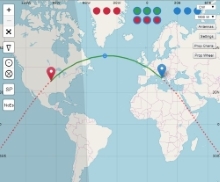Re: indici attività solare
naturalmente, ad una più intensa attività solare, come in questi giorni, corrisponde anche un maggiore rischio di tempeste geomagnetiche a seguito di flares particolarmente violenti. Ieri si è verificato un flare di classe X, proprio in seno alla regione attiva 1944 che fronteggia in pieno la Terra.

Ne è seguita a breve una "solar radiation storm", con una nuova impennata del flusso di protoni ad alta energia , registrata dal satellite GOES-13:

e, stando a quanto si è visto sulla sonda SOHO LASCO C3, dovrebbe essere stata rilasciata una importante CME:

Aspettiamoci, pertanto, un significativo deterioramento delle condizioni geomagnetiche , non appena la CME sarà giunta in prossimità della Terra (si prevede per domani). Buona Aurora per chi potrà vederla:
Ecco, infine, cosa segna oggi il mio Ionoprobe (by VE3NEA):

G2 = http://www.swpc.noaa.gov/NOAAscales/index.html#G2
S2 = http://www.swpc.noaa.gov/NOAAscales/index.html#S2
R1 = http://www.swpc.noaa.gov/NOAAscales/index.html#R1
naturalmente, ad una più intensa attività solare, come in questi giorni, corrisponde anche un maggiore rischio di tempeste geomagnetiche a seguito di flares particolarmente violenti. Ieri si è verificato un flare di classe X, proprio in seno alla regione attiva 1944 che fronteggia in pieno la Terra.
Ne è seguita a breve una "solar radiation storm", con una nuova impennata del flusso di protoni ad alta energia , registrata dal satellite GOES-13:
e, stando a quanto si è visto sulla sonda SOHO LASCO C3, dovrebbe essere stata rilasciata una importante CME:
Aspettiamoci, pertanto, un significativo deterioramento delle condizioni geomagnetiche , non appena la CME sarà giunta in prossimità della Terra (si prevede per domani). Buona Aurora per chi potrà vederla:
Middle Latitude Auroral Activity WARNING
Issued: 06:55 UTC, 08 January 2014
Solar Terrestrial Dispatch
www.spacew.com
A major class X1.2 solar proton flare was observed on 7 January. It was
associated with a fast coronal mass ejection that had an estimated velocity
between approximately 1500 and 2300 km/sec. Our analysis suggests the
disturbance could arrive as early as the early hours of 9 January (UTC
time) to as late as the late afternoon hours of 9 January (UTC time).
Preferred impact time is between 04:00 to 09:00 UTC on 9 January.
The arrival of this disturbance will likely produce periods of strong
auroral storm activity that may be occasionally visible into the low
latitude regions (i.e. southern U.S. states). Most of the activity will
likely be visible from well south of the U.S./Canada border and into the
southern U.K. and through central to northern Europe. As well, southern
regions of Australia and New Zealand should also spot periods of activity.
The disturbance will likely last approximately 12 to 18 hours. The best
opportunity to view activity, given the increasing interference of the
moon's brightness, will be in the hours after local midnight.
End of WARNING statement
Issued: 06:55 UTC, 08 January 2014
Solar Terrestrial Dispatch
www.spacew.com
A major class X1.2 solar proton flare was observed on 7 January. It was
associated with a fast coronal mass ejection that had an estimated velocity
between approximately 1500 and 2300 km/sec. Our analysis suggests the
disturbance could arrive as early as the early hours of 9 January (UTC
time) to as late as the late afternoon hours of 9 January (UTC time).
Preferred impact time is between 04:00 to 09:00 UTC on 9 January.
The arrival of this disturbance will likely produce periods of strong
auroral storm activity that may be occasionally visible into the low
latitude regions (i.e. southern U.S. states). Most of the activity will
likely be visible from well south of the U.S./Canada border and into the
southern U.K. and through central to northern Europe. As well, southern
regions of Australia and New Zealand should also spot periods of activity.
The disturbance will likely last approximately 12 to 18 hours. The best
opportunity to view activity, given the increasing interference of the
moon's brightness, will be in the hours after local midnight.
End of WARNING statement
Ecco, infine, cosa segna oggi il mio Ionoprobe (by VE3NEA):
G2 = http://www.swpc.noaa.gov/NOAAscales/index.html#G2
S2 = http://www.swpc.noaa.gov/NOAAscales/index.html#S2
R1 = http://www.swpc.noaa.gov/NOAAscales/index.html#R1







Commenta